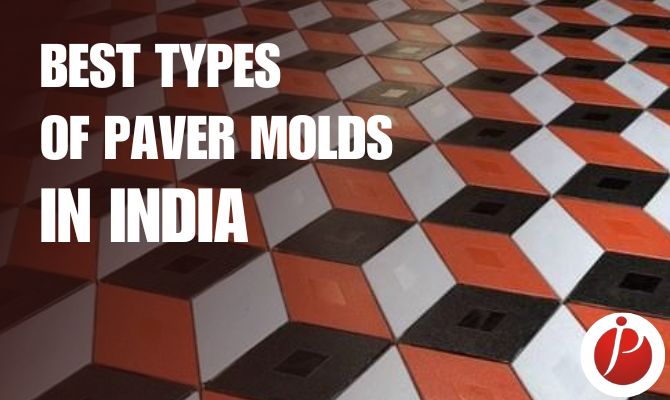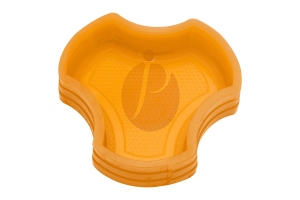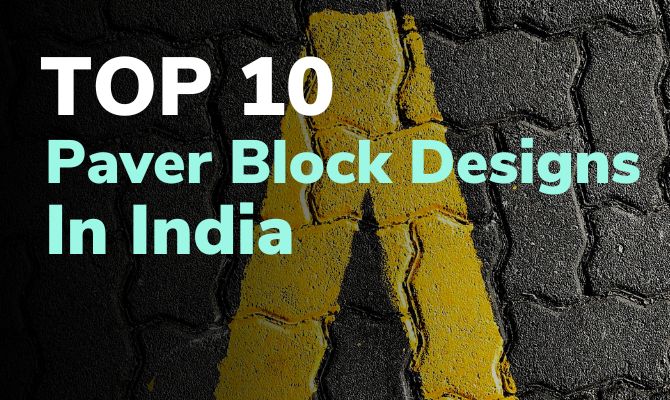- Get The Best Quality Molds From Us
- +91 9687244343
- +91 9687245001
- support@jpmoulds.in

Best Types of Paver Molds in India
May 21, 2023
PVC Paver Molds vs. Plastic Paver Molds
June 27, 2023How to Manufacture the Best Quality Paver Blocks?
In this article, we will understand various techniques for manufacturing paver blocks. Moreover, we will understand the best way to manufacture paver blocks.
Paver Block: A stepping stone of Revolution
Paver Blocks are one of the most creative inventions in mankind. The blocks are shaped in such a way that they interlock within themselves. As a result, we can experience beautiful pavements in front of our eyes. The geometric shapes and designs with the right color combination make the pavement even more eye-catching.
There is a deep history of interlocking paver blocks. However, we will understand what a paver block is.
What are Paver Blocks?
Paver blocks, also known as paving stones or concrete pavers, are essential components used in constructing various paved surfaces, including roads, walkways, driveways, patios, and more. Made primarily from concrete, these versatile units are designed to interlock, creating stable and durable surfaces. Paver blocks come in a wide array of shapes, sizes, colors, and finishes, offering ample design options for different projects.

Manufactured by mixing concrete, water, and aggregates, paver blocks are poured into molds to achieve desired shapes and textures. Once cured, these blocks are ready for installation. Their interlocking capability is a key feature, ensuring a secure fit that can withstand heavy loads and resist movement.
Paver blocks offer numerous advantages over traditional pavement materials, such as asphalt or poured concrete. They are renowned for their durability, crack resistance, and ease of repair. Should any block get damaged, it can be replaced without the need for extensive pavement work.
Moreover, paver blocks provide a high level of customization, enabling various patterns like herringbone, basket weave, or circular designs. With a broad spectrum of colors and textures available, they allow for visually appealing and unique outdoor spaces.
When it comes to creating long-lasting and visually pleasing paved surfaces, paver blocks are a favored choice. Their functionality and aesthetic benefits make them an ideal solution for, both, residential and commercial projects.
Benefits of paver blocks
There are many benefits of paver blocks. Here are a few of them:
1. Durability: Paver blocks are highly durable and can withstand heavy loads, making them ideal for driveways, parking lots, and high-traffic areas.
2. Flexibility: The interlocking design of paver blocks allows for slight movement without causing cracks or damage, making them resistant to shifting soil and freeze-thaw cycles.
3. Easy Maintenance: Paver blocks are relatively easy to maintain. If a block gets damaged or stained, it can be individually replaced without disrupting the entire pavement.
4. Design Versatility: Paver blocks come in a wide range of shapes, sizes, colors, and textures, providing endless design possibilities. They can be arranged in various patterns, creating unique and visually appealing surfaces.
5. Enhanced Aesthetics: Paver blocks add a touch of elegance and sophistication to outdoor spaces.
6. Slip Resistance: Paver blocks offer good traction, reducing the risk of slips and fall. Textured or tumbled paver blocks provide additional grip, especially in wet or icy conditions.
7. Environmental Friendliness: Paver blocks are environmentally friendly as they allow rainwater to permeate through the gaps between the blocks, reducing runoff and helping with groundwater recharge.
8. Longevity: When properly installed and maintained, paver blocks can last for decades, providing a long-term and cost-effective solution for paved surfaces.
9. Quick Installation: Paver blocks are relatively quick and easy to install compared to other pavement options.
10. Increased Property Value: The addition of well-designed paver block features can enhance the curb appeal and value of a property, making it an attractive investment.
Incorporating paver blocks into your outdoor spaces offers numerous benefits, from durability and design flexibility to easy maintenance and improved aesthetics. Whether for residential or commercial projects, paver blocks are a reliable and visually appealing choice for paved surfaces.
The Manufacturing Process of Paver Blocks
There are 2 primary ways to produce paver blocks: 1. Hydraulic Press Machines 2. Paver block molds.
Let us understand both ways in detail.
1. Hydraulic Press Machine
Hydraulic press machines have long been a staple in various industries involved in manufacturing intermediate parts or goods. These machines utilize hydraulic pressure, generated by hydraulic fluids, to bend input materials or mixtures into the desired shapes and sizes. Within these machines, the crucial role of the Mother Mould cannot be understated. It not only ensures size and shape retention but also greatly influences the overall quality, shine, and fitting of the final product.
In certain cases, hydraulic press machines are used exclusively for the production of pavers, following government guidelines. The conditions that warrant the use of hydraulic press machines for paver block production are as follows:
1. When a large quantity of pavers is required.
2. When a regular design without color variations is needed.
3. When high strength is not a significant requirement for the pavers.
If at least two of the above three conditions are met, it becomes feasible to obtain and lay Paver Blocks produced by hydraulic press machines.
However, there are many limitations to a hydraulic press machine.
Limitations of a Hydraulic Press Machine:
Paver blocks produced by these machines possess certain limitations in terms of product quality, variety, strength, and fitting. A crucial component of the machinery is the Mother Mould, which imparts the desired shape and size to the concrete mixture filled into it through a comprehensive Hopper Feeder System.
To manufacture a specific design at a given size, a separate Mother Mold is required. For example, for a 60mm and 80mm variant of the same design, two different molds would be needed. The cost of these molds ranges from INR125,000 to INR380,000, depending on the requirements.
Another limitation concerns the strength of the paver blocks. When the concrete mixture is injected into the mold, it contains only 20% water, resulting in a semi-solid mixture. Despite compressing the bricks with hydraulic pressure and vibrations, air gaps remain evident within the blocks.
These gaps contribute to the reduced strength of the blocks, leading to failures in strength tests. When comparing paver blocks made using rubber paver molds and those made with press machines, there is a significant difference of approximately 25% in favor of rubber molds in terms of strength.
The third limitation concerns the inability to produce colored pavers using hydraulic press machines. Typically, the concrete poured into the machine is colorless. Introducing color to the entire batch would increase the production cost, and customers are often unwilling to pay a higher price for pressed pavers.
Moreover, the color used is iron oxide pigment, available in red, yellow, and black. Injecting this pigment into a steel Mother Mould would cause abrasion due to friction between the iron oxide and the steel, rendering the mold useless.
Furthermore, the pressed pavers produced would start cracking as the deteriorated sides of the mold result in a loss of smoothness.
Manufacturing Process
The first step in manufacturing paver blocks involves procuring the necessary materials, including cement, stone chips (6mm), sand, water, and a hardener chemical. Cement and sand are mixed with water in a concrete mixer until the mixture reaches a semi-liquid consistency. Stone chips are added along with hardener chemicals to enhance strength and structural integrity.
Once the mixture turns metallic grey and achieves a semi-solid state, it is fed into the machine’s feeder manually or through a conveyor belt. The concrete mixture enters the machine’s Mother Mould, which molds a specific design with a particular thickness. Hydraulic pressure ranging from 5 to 15 metric tons is applied to compress the concrete into the shape of the mold.
After 45 seconds of pressure, the machine initiates vibration, further compressing the concrete and pushing it out of the mold onto the trays below. The number of pavers produced per cycle depends on the machinery and mold size, typically ranging from 6 to 12 for zig-zag designs.
The trays holding the pavers are then stacked on top of each other for drying. Drying hydraulic press pavers is a three-day process, with the first two days dedicated to drying and the third day to water curing. Water curing is an additional step to increase the pavers’ strength.
It’s important to note that the actual strength test should not be conducted until 28 days have passed to obtain accurate results. After five days after the manufacturing date, the pavers are ready for dispatch.
By following these manufacturing steps, paver blocks are produced with strength, durability, and versatility, suitable for various construction applications.
2. Paver Molds
An alternative method of manufacturing paver blocks involves pouring a specially formulated concrete mixture into the molds. There are two types of paver molds commonly used for this purpose: plastic molds and rubber molds.
Rubber Paver Molds:
The most effective method of manufacturing pavers today is through the use of rubber paver molds. These molds address the limitations of other manufacturing methods and offer several advantages over them. Rubber paver molds can be categorized into two types: PVC molds and natural rubber molds.

PVC Paver Molds:
PVC paver molds are highly regarded and widely used in India. PVC, known for its versatility, finds application in various industries. It can be manufactured in different hardness variants, allowing for the production of both soft and robust products.
Paver molds made from this compound have a lifespan of approximately 4.5 years or even longer. These molds excel in aspects such as shine, strength, finishing, shape retention, and fitting.

Natural Rubber Molds:
Natural rubber molds, made from abundant Kerala rubber, are predominantly used in southern India due to their cost-effectiveness. These molds have a lifespan ranging from 1 year to 2.5 years.
However, they face challenges related to constant abrasion during the paver production process, which leads to erosion and reduced durability.
Plastic Paver Molds:
Plastic molds rank second in popularity for manufacturing paver blocks. They are favored for their lightweight nature, affordability, and relatively better performance compared to hydraulic-pressed paver blocks.
These molds are created using an injection molding machine and vary in weight (100 grams to 380 grams) based on shape, size, and quality.
Plastic molds are cost-effective due to their reduced weight but have a shorter lifespan. Close monitoring is essential during paver production to ensure their proper functionality.
Although plastic molds retain their shape well, their lack of flexibility makes them prone to breakage, reducing their reliability. Careful handling is required to mitigate the risk of fractures and damage.
Manufacturing Process
The procurement of materials for the molds is similar. Additional materials required include color pigment, 12mm stone chips, and alcohol-based lacquer polish.
When producing pavers using molds, the need for a colored top layer determines the process. If not required, the cement mixture is poured as is. If a colored top is desired, separate layers of the colored and non-colored mixture are created. This minimizes overall costs. The batches for each layer have different formulations.
For the top layer, a color mixer is used to combine cement, sand, water, hardener, color powder, and 6mm stone chips. The quantity depends on the number of paver molds. A higher cement ratio ensures a seamless shining surface. The mold used also affects the shine.
In the bottom layer, mixed in a concrete mixer, 12mm stone chips are added for strength. This layer provides greater structural integrity compared to hydraulic-pressed pavers.
The filling process varies for rubber and PVC molds. Plastic molds require the application of releasing agents like shuttering oil. This eases the demolding process. Other steps remain the same for both mold types.
The mixture from the color mixer is filled into the molds up to 10mm. Then, it is passed onto a vibrating table for even settling. The molds are then filled to the brim with the concrete mixture, followed by another round of vibration to remove air bubbles. The filled molds are stacked on plastic sheets and left to dry for 24 hours.
After the drying period, the pavers can be de-molded without any additional agent. They are then stacked and, if desired, a lacquer polish is applied using a sponge to enhance their shine.
Conclusion
By understanding these manufacturing techniques and considering the specific requirements of each project, it is possible to produce the best quality paver blocks that meet durability, strength, and aesthetic standards.
Whether for residential or commercial applications, paver blocks offer a reliable and visually appealing solution for creating beautiful paved surfaces.


